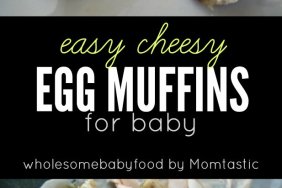Image: Getty
Learn about feeding baby first solid foods and the different stages of solid foods
Feeding Your Baby First Solid Foods or Jump to Solid Food Feeding Stages
Most Important: Offer your baby only those foods that are appropriate for the age of your baby.
You’re baby will be more interested in solids when he/she is a little hungry but not starving – offer breast milk and/or formula first and then offer solids. If you are trying to feed a baby solids when she is very hungry, she may be more likely to resist.
Solid foods are a new experience and sometimes, baby may just be too hungry to want to sit for the new experience. She may not want to accept the spoon, the new tastes and the new textures.
Remember, solid foods are not meant to provide for baby nutritionally in the first few months, breast milk and/or formula fill this role.
ALWAYS ensure that your baby is sitting upright. If he cannot sit upright unassisted and does not have proper head control, it may not be the right time to begin solid foods. When he in a highchair or other infant-specific chair then he is less likely to choke. Never leave your baby unattended when he eating.
Introduce New Foods During the Morning or Early Afternoon
Introduce new foods during the morning or early afternoon. This will enable you to deal with any adverse reactions when your pediatrician is in office. Should an adverse reaction occur during the morning/early afternoon, it will cause the least amount of disruption in baby’s fragile routine.
Further, you should always introduce new foods after a nursing or bottle feeding. Your baby still receives his main source of nutrition from either breast milk or formula up to the one year old mark – do not let solids interfere with liquid intake.
Make it a Family Affair! Why not feed baby with the whole family instead of all by himself in his highchair? Place the highchair or feeding seat at the family table. Allow baby to sit at the family table even if baby is not going to be eating. This will help baby become accustomed to mealtime routines. Your baby will enjoy being part of the “action” at the table.
Use a Comfy Utensil When Feeding Your Baby
Ensure you are using a soft comfy spoon. Remember baby’s gums may be tender from teething and a hard metal spoon may aggravate baby’s gums. If she refuses the spoon or if the spoon seems to make baby uncomfortable, use your finger. Many parents begin offering their babies solid foods by using their (clean and washed) finger as a spoon.
Don’t Make a Fuss Over the Feeding Session
Don’t make a fuss over the food – talk about the food you are offering and make some “yum yum” sounds however, ensure that you are not overwhelming your baby with your words and sounds. This may distract baby’s attention from the food and over-stimulate baby.
Follow your baby’s cues and allow him or her to explore the dish, utensils and the food itself. We always gave our babies their own spoon and a little bowl of food as we fed them.
Don’t Force Your Baby to Eat
Don’t force foods on your baby. If your baby does not open his or her mouth for the food immediately, wait for baby to open his mouth when food is offered. Always let her eat at her own pace and on her own terms. When baby turns her head away or stops opening her mouth, this probably means she had had enough; respect that and stop offering the food. You don’t want to continue to offer foods and run the risk of overriding her own appetite control system.
It’s ok if baby does not finish a “meal”. When baby signals she is done, then trust your baby’s instincts. Read How Much Food Should My Baby Eat? for more information.
Offer a Variety of Foods and Colors & You’ll be Offering all the Nutrients Needed!
Offer your baby different foods once you have begun to introduce several foods. Use different ways of preparing those baby foods and be willing to have a huge store of patience.
Don’t give up on a new food because baby won’t eat it the first time; continue offering the food or wait another day or week.
HAVE FUN and Don’t Sweat the Mess
SOLID FOOD FEEDING STAGES:
Below is a short example of Feeding Stages a baby may go through. Please keep in mind that the ages shown are age ranges. It is impossible to accurately reflect specific foods and feeding patterns for all infants; infants begin solid foods at differing ages and thus their progression into solid foods may differ greatly. Always remember that solids do not replace the necessary nutrients or breast milk and/or formula in the first 12 months of life.
(4)6-8 Months – Baby Let’s Begin to Eat
“Baby” cereal and soft cooked thinly pureed fruits and veggies should be baby’s first solid food experiences. Single ingredients only and at a space of 4 days apart with introducing each new food. You may skip the cereal and begin with a fruit like avocado or begin with a veggie like butternut squash or sweet potato.
8-10 Months – We’re Moving On
Bring on some spices and the softly mashed, or chopped into fine pieces of fruits, vegetables, meats, pasta and dairy such as yogurt and cheeses. Pasta, veggies, and fruit should all be soft cooked and possibly mashed with a fork or masher. (Bananas need only be mashed.) Raw fruits are often introduced at this stage. Meats and proteins such as egg yolk, should be cooked and pureed or chopped into small soft bits. If offering Tofu, you need not cook it first. Ensure dairy offered is easily manageable.
Remember, baby will not have molars until sometime around the 12-18 month age range. Foods should be easily mashed between the gums.
11-12 Months – We’re almost Toddlers now and we want to eat grown-up foods.
By this stage, your baby should be just on the brink of or is already eating “table foods“. She may already love self-feeding and may enjoy a variety of spices in her cuisine. Encourage a healthy exploration of foods, tastes and textures as well as eating utensils.
Always keep in mind that certain foods may still pose an allergy or other type of reaction risk.
RELATED ARTICLES
-
Transitioning to Sippy Cups between ages 6 months to 12 months.
-
Solid Food Stages & Feeding First SolidsMonth Range of Feeding Stages & Tips for Feeding First Solid Foods.
-
Introducing Solid Foods by Age Chart for information about what food to avoid and what foods are appropriate for certain ages.
-
How Much Food Should Your Baby Eat? Read our article and ease your mind.
-
Is My Baby Ready for Solids? Explore some key signs and points about the readiness for solid, complementary feedings.


